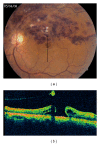Macular hole progression after intravitreal bevacizumab for hemicentral retinal vein occlusion
- PMID: 22606470
- PMCID: PMC3350047
- DOI: 10.1155/2011/679751
Macular hole progression after intravitreal bevacizumab for hemicentral retinal vein occlusion
Abstract
Macular edema secondary to retinal vein occlusion is commonly being treated with off-label intravitreal bevacizumab with good outcomes. A significant reduction in macular edema and improvement in visual acuity is seen following such a treatment with no serious adverse effects. In the reported case, a full-thickness macular hole was noticed one month after intravitreal bevacizumab for macular edema secondary to hemicentral retinal vein occlusion. On a detailed review of the pre- and postoptical coherence tomography scans, it was realized that there was a preexisting stage 2-3 macular hole which was masked by the hemorrhages and edema at the fovea and the macular hole had progressed following the injection.
Figures


Similar articles
-
Clinical, anatomical, and electrophysiological assessments of the central retina following intravitreal bevacizumab for macular edema secondary to retinal vein occlusion.Int Ophthalmol. 2016 Feb;36(1):21-36. doi: 10.1007/s10792-015-0066-6. Epub 2015 Mar 29. Int Ophthalmol. 2016. PMID: 25820576
-
"Off-label" use of intravitreal bevacizumab in non-ischemic macular edema secondary to retinal vein obstructions.Rom J Ophthalmol. 2016 Apr-Jun;60(2):90-95. Rom J Ophthalmol. 2016. PMID: 29450329 Free PMC article.
-
EFFICACY AND FREQUENCY OF INTRAVITREAL AFLIBERCEPT VERSUS BEVACIZUMAB FOR MACULAR EDEMA SECONDARY TO CENTRAL RETINAL VEIN OCCLUSION.Retina. 2018 Sep;38(9):1795-1800. doi: 10.1097/IAE.0000000000001782. Retina. 2018. PMID: 28767552 Clinical Trial.
-
A comparison of three different intravitreal treatment modalities of macular edema due to branch retinal vein occlusion.Curr Eye Res. 2010 Oct;35(10):925-9. doi: 10.3109/02713683.2010.496540. Curr Eye Res. 2010. PMID: 20858114 Clinical Trial.
-
Prospective study of intravitreal triamcinolone acetonide versus bevacizumab for macular edema secondary to central retinal vein occlusion.Retina. 2011 May;31(5):838-45. doi: 10.1097/IAE.0b013e3181f4420d. Retina. 2011. PMID: 21293319 Clinical Trial.
Cited by
-
Case of Repeated Full-Thickness Macular Hole Formations and Spontaneous Closure following Intravitreal Bevacizumab Treatment for Central Retinal Vein Occlusion.Case Rep Ophthalmol. 2022 Nov 18;13(3):981-987. doi: 10.1159/000527211. eCollection 2022 Sep-Dec. Case Rep Ophthalmol. 2022. PMID: 36466066 Free PMC article.
-
Macular Hole Progression following Ocriplasmin Intravitreal Injection.Case Rep Ophthalmol Med. 2014;2014:403461. doi: 10.1155/2014/403461. Epub 2014 Dec 14. Case Rep Ophthalmol Med. 2014. PMID: 25580329 Free PMC article.
-
Full-thickness macular hole formation following antivascular endothelial growth factor injection in a case of hemicentral retinal vein occlusion.Oman J Ophthalmol. 2021 Feb 27;14(1):49-51. doi: 10.4103/ojo.OJO_103_2020. eCollection 2021 Jan-Apr. Oman J Ophthalmol. 2021. PMID: 34084036 Free PMC article.
-
Macular hole formation following intravitreal injection of ranibizumab for branch retinal vein occlusion: a case report.BMC Res Notes. 2015 Aug 19;8:358. doi: 10.1186/s13104-015-1324-4. BMC Res Notes. 2015. PMID: 26285577 Free PMC article.
-
Full-Thickness Macular Hole After Intravitreal Conbercept Injection in Branch Retinal Vein Occlusion.Cureus. 2023 Feb 5;15(2):e34660. doi: 10.7759/cureus.34660. eCollection 2023 Feb. Cureus. 2023. PMID: 36909051 Free PMC article.
References
-
- Pai SA, Shetty R, Vijayan PB, et al. Clinical, anatomic, and electrophysiologic evaluation following intravitreal bevacizumab for macular edema in retinal vein occlusion. American Journal of Ophthalmology. 2007;143(4):601–606. - PubMed
-
- Costa RA, Jorge R, Calucci D, Melo LA, Cardillo JA, Scott IU. Intravitreal bevacizumab (Avastin) for central and hemicentral retinal vein occlusions: IBeVO study. Retina. 2007;27(2):141–149. - PubMed
-
- Gutman FA, Zegarra H. Macular edema secondary to occlusion of the retinal veins. Survey of Ophthalmology. 1984;28, supplement:462–470. - PubMed
-
- Glacet-Bernard A, Voigt M, Coscas G, Soubrane G. Full-thickness macular hole following intravitreal injection of triamcinolone acetonide in central retinal vein occlusion. Retinal Cases and Brief Reports. 2007;1:62–64. - PubMed
-
- Lattanzio R, Ramoni A, Scotti F, Introini U. Macular hole and intravitreal injection of triamcinolone acetonide for macular edema due to central retinal vein occlusion. European Journal of Ophthalmology. 2007;17(3):451–453. - PubMed
Publication types
LinkOut - more resources
Full Text Sources

